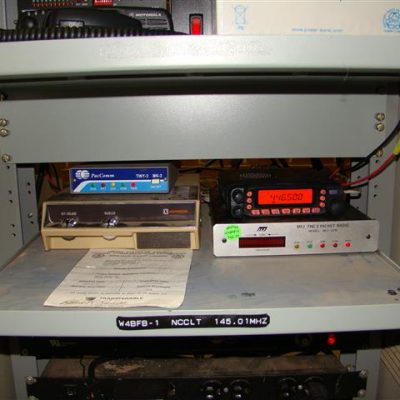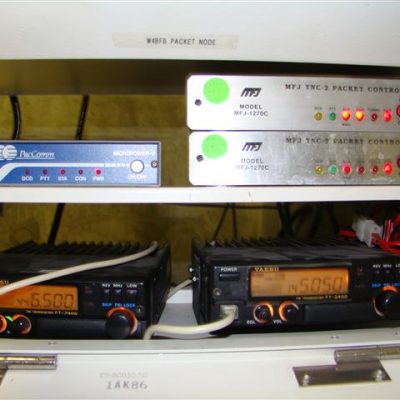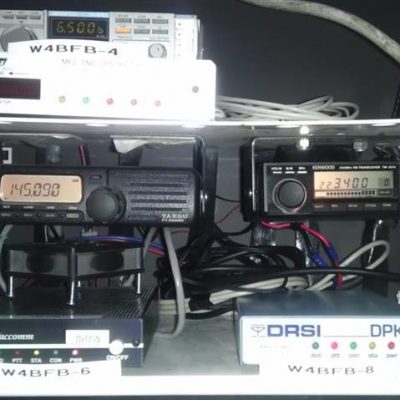Packet Radio Information
In the early 1980’s, personal computers were gaining acceptance as a required piece of gear in the modern hamshack.
In the commercial computer world, the X.25 protocol had gained acceptance as an efficient data transmission protocol, using virtual circuits (connect / disconnect), and packets of data, sharing the same telephone line. (X.25 was originally defined by the International Telegraph and Telephone Consultative Committee (CCITT, now called ITU-T) in a long series of drafts and finalized in a publication known as The Orange Book in 1976.)
Talented amateurs from Tuscon, AZ, packaged a very good subset of X.25 (first called AX.25) into a little box called a “Terminal Node Controller” (TNC) and Packet Radio, as we still know it, was born.
In short order, Amateur Radio operators were on the air, using AX.25 to create and use virtual circuits, and packets of data, all sharing the same radio frequency. Nodes were created as relays, for traffic to be delivered to even further distances than their own radios could cover. (Think of a node like one thinks of a repeater, but for digital keyboarding and messages to be relayed to their destination from higher elevation points!)
MARS™ created node: W4BFB-1, on 145.010 MHz, and our first “packet node” was installed on Anderson Mtn, where we could connect to other packet stations.
As packet radio use and the number of nodes exploded, “frequency coordination” came about, and the club updated W4BFB-1 to fit into the exploding packet networks in our region.
To this day, MARS’ Amateur Radio Packet Network, with its flagship station W4BFB-1, remains in operation for use by all licensed amateur radio operators 24/7.
Today, at the center of the MARS packet system is our Full Service BBS (Bulletin Board System) located in the MARS clubroom at the Charlotte Red Cross building. This W4BFB packet node is named (CLTBBS or W4BFB-9). It runs via a BBS program called BPQMail and is connected to the outside world by 3 backbone radios operating on: 145.010 MHz, 223.400 MHz, and 446.500 MHz at 1200 baud. The BBS also sends and receives “forwarded traffic” through an “AX/IP gateway”, which provides the ability to use the internet to transfer traffic, and allows for faster message and traffic links all across the Carolinas, to many locations that are available via RF, but slower to connect. It also allows for inter-connection to world-wide nodes to enable communication with amateur operators near and far.
***NOTE: MARS-W4BFB prides itself in ensuring that “RF redundancy” is in place, and active at all times, in the event that the internet were to fail. During emergency situations, RF packet radio may be used to reliably deliver messages such as NTS traffic, ARES bulletins, and other messages to authorities. Although the internet is available for partial links to our backbone, the RF network is always in place and ready for operation.
Our W4BFB nodes are located at high places allowing us to automatically forward BBS and NTS traffic to and from hundreds of other BBS’s throughout the world from our own CLTBBS. Each node consists of two or more radios, each radio with its TNCs, connected directly, or via a diode matrix, to other TNCs in that node. In each TNC, there is an EPROM (erasable programmable read only memory) containing the “NET/ROM” program giving the TNC the “intelligence” to be a “network node”. This capability allows for automatic routing of traffic from a local single node to distant nodes within the network.
Our central node is (W4BFB-10 or CLTRC), which is the “hub” of the W4BFB system. (CLTRC is a packet nickname for Charlotte Red Cross) This allows user access and BBS traffic in and out of our MARS clubroom from 145, 220, 440 MHz, plus AX/IP internet linked stations. This system is powered by PC software called BPQ32. The computer is a Windows XP® machine, with multiple TNCs connected to the communication ports on the back. The CLTRC node is operating as a “software based” node in the clubroom. This NET/ROM system links to all other nodes in our Charlotte system improving automatic routing of traffic across our area.
Our Anderson Mtn node, (W4BFB-1 or NCCLT) at 145.010 MHz, is coupled with (W4BFB-11 or #CLT44) at 446.500 MHz, which allows forwarding of packet messages in and out of our local area or to our own CLTBBS. (This node-stack is currently offline for maintenance.)
* Currently offline * We have the (W4BFB-5 or CLT) node on top of the Duke Power building, in uptown Charlotte, at 145.010 MHz. It is coupled with (W4BFB-7 or CLT220) on 223.400MHz and (W4BFB-14 or CLT440) at 446.500 MHz, forwarding packet messages in and out of our local area, or to our own BBS.
In Northeast Charlotte, (KE4IYH-4 or CLTNE) at 145.090 MHz, is coupled with (KE4IYH-14 or CLT442) at 446.500 MHz. It serves Eastern Charlotte, and provides pathways to Anderson Mountain and the CLTBBS. The frequency 145.090 MHz is considered an “end-user frequency” and is intended for direct keyboard-to-keyboard access as well as connecting to the BBS and/or local DX Cluster to use it’s services.
The W4BFB node and equipment located at Spencer Mtn. in Ranlo, NC, (W4BFB-6 or SPENCE) on 145.090 MHz and coupled with (W4BFB-8 or SPN220) on 223.400 MHz, is one of our best coverage nodes and was installed in August of 2013. This site has a great view at 1300 ft. and provides coverage to most packeteers to the North and West of Charlotte. The 220 backbone gives a quick path to the CLTBBS and CHAT systems!
The W4BFB node and equipment located at the Bethel Fire Station in Clover SC, (W4BFB-6 or CLOVER) on 145.710 MHz and coupled with (W4BFB-8 or CLO220) on 223.400 MHz, was deactivated in 2011 due to damage at the site. The equipment was relocated to Spencer Mtn, NC.
Regional and world-wide packet radio connections may be made using the Charlotte W4BFB packet radio system. Our MARS RF nodes can currently reach as far as Hendersonville, NC to the West – Raleigh, Myrtle Beach, SC – Sauertown Mtn, NC to the North – and Lancaster, SC to the South, using ONLY RF!
Although this page mostly talks about the nodes offered by W4BFB and a few of the features, we also have many services that are offered using packet radio. NTS messages can be sent in “Radiogram” format using our BBS (W4BFB-9), as well as personal (non-traffic) messages for users of the BBS locally and world-wide! We host a 24/7 CHAT server (W4BFB-2) that is linked to many other nodes around the world so that you can enjoy chatting with someone at nearly any hour of the day. There are several RMS Gateways in the area that can be accessed by our packet system as well. You can access these gateways 24/7 and RMS maps can be viewed at: www.winlink.org/RMSPacketPositions.
Several operators in the area also have “backbone links” to world-wide (WW) nodes using internet and/or HF links. Currently, the Charlotte system can connect to (AC4ZR-1), (KF4LLF-7) (KK4HOK-7) or (W4PFI-8) who operate “internet AX/IP gateway” links to nodes all over the world.
Finally, getting on packet radio is fairly easy if you have the right instructions… We offer a Packet Radio Portal that gives users access to packet radio through this website! (You must be a licensed amateur operator to use the features on the portal page once you’re there.) Follow the link for instructions on how to get on packet radio using RADIOS and also how to use our WEB TERMINAL! Click here for the Packet Radio Portal.
PACKET RADIO IS FM SIMPLEX ON:
- 145.010 (BBS Traffic & Forwarding)
- 145.090 (Keyboard Users & Nodes)
- 223.400 (Keyboard Users & Backbone Use)
- 446.500 (NC State Backbone Frequency, Nodes Only)
MARS-Packet Network/BBS sysops: Bill (AC4ZR), Seth (KF4LLF), and Steve (KE4IYH).
MARS Repeater Committee Chairman: Earl Fortner (K4KAY)
Regional Packet Radio Networks and PBBS
Click Here to view in a larger screen.
For additional information on Amateur Radio Packet Radio, visit: TAPR (Tucson Amateur Packet Radio)


